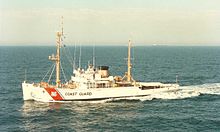
USS Noxubee (AOG-56) was a Patapsco-class gasoline tanker acquired by the U.S. Navy for the task of transporting gasoline to warships in the fleet, and to remote Navy stations. She served in a commissioned status from 1945 to 1959, and 1965–1975. She was named for a river in Mississippi.

USS Atakapa (ATF-149) was an Achomawi class of fleet ocean tug. It was named after the Atakapa Native American tribe that once inhabited territory which is now southwestern Louisiana and southeastern Texas.

USS Salvager, a Gypsy-class salvage lifting vessel of the United States Navy, was originally conceived as LSM-551, was reclassified ARS(D)-3 on 24 April 1945; named Salvager on 1 May 1945; laid down on 27 August 1945 by the Brown Shipbuilding Corporation, Houston, Texas; launched on 7 December 1945; and commissioned on 22 March 1946.

USS Mender was a Gypsy-class salvage lifting vessel of the United States Navy. Originally designated LSM‑550, she was reclassified on 24 April 1945, and was laid down on 25 August 1945 by Brown Shipbuilding Corporation, Houston, Texas. Launched on 7 December 1945; and commissioned on 8 March 1946.

USS McCloy (FF-1038) was the second and final Bronstein-class frigate. Commissioned as a destroyer escort, McCloy was redesignated as frigate on 30 June 1975. Decommissioned on 14 December 1990, and stricken from the Navy list on 4 October 1991, McCloy was transferred to Mexico on 12 November 1993, where she was recommissioned as Nicolas Bravo. Named for Lt. Comdr. John C. McCloy, recipient of two Medals of Honor.

USS Huse (DE-145) was a U.S. Navy destroyer escort launched by Consolidated Steel Corp., Orange, Texas on 23 March 1943, during World War II. The ship was sponsored by Mrs. L. M. Humrichouse, daughter of Admiral Harry McLaren Pinckney Huse, whom the ship was named after and commissioned on 30 August 1943.

USS Owl (AM-2) was an Lapwing-class minesweeper acquired by the U.S. Navy for the dangerous task of removing mines from minefields laid in the water to prevent ships from passing.

USS Seneca (AT-91) was a Navajo-class fleet tug constructed for the United States Navy during World War II. Her purpose was to aid ships, usually by towing, on the high seas or in combat or post-combat areas, plus "other duties as assigned." She served in the Atlantic Ocean performing various tasks.

USS Salinan (ATF-161) was an Achomawi-class tug built for the United States Navy during World War II. Named after the Salinan peoples, she was the only U.S. Naval vessel to bear the name.

USS Grapple (ARS-7) is a Diver-class rescue and salvage ship commissioned in the United States Navy from 1943 to 1946 and from 1951 to 1977. In 1977, she was sold to Taiwan and was renamed ROCS Da Hu (ARS-552).

USS Preserver (ARS-8) was a Diver-class rescue and salvage ship commissioned by the U.S. Navy for service in World War II. She was responsible for coming to the aid of stricken vessels.

USS Shackle (ARS-9) was a Diver-class rescue and salvage ship commissioned by the U.S. Navy for service in World War II. She was responsible for coming to the aid of stricken vessels.

USS Chain (ARS-20/T-AGOR-17) was a Diver-class rescue and salvage ship commissioned by the U.S. Navy during World War II. Her task was to come to the aid of stricken vessels.
USS Curb (ARS-21) was a Diver-class rescue and salvage ship commissioned by the U.S. Navy during World War II. Her task was to come to the aid of stricken vessels.

USS Grasp (ARS-24) was a Diver-class rescue and salvage ship commissioned by the U.S. Navy during World War II. Her task was to come to the aid of stricken vessels.

USS Hoist (ARS-40) was a Bolster-class rescue and salvage ship acquired by the United States Navy during World War II. Its task was to come to the aid of stricken vessels.

USS Opportune (ARS-41) was a Bolster-class rescue and salvage ship acquired by the U.S. Navy during World War II. Her task was to come to the aid of stricken vessels.

USS Recovery (ARS-43) was a Bolster-class rescue and salvage ship of the United States Navy, which remained in commission for over 48 years.

ATA-190, originally projected as ATR-117, was laid down on 29 September 1944 by the Levingston Shipbuilding Co., Orange, Texas; launched on 26 October 1944; and commissioned on 1 January 1945.

The third USS Kiowa (AT-72), later ATF-72, was a fleet tug, later fleet ocean tug, that served in the United States Navy from 1943 to 1972.




















